Related Research Articles
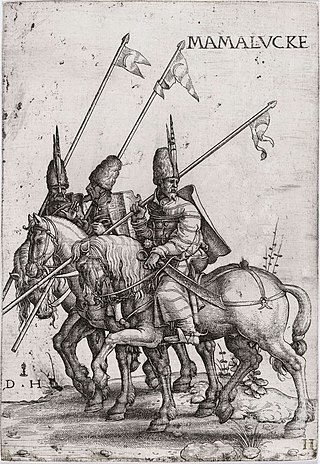
Mamluk were non-Arab, ethnically diverse enslaved mercenaries, slave-soldiers, and freed slaves who were assigned high-ranking military and administrative duties, serving the ruling Arab and Ottoman dynasties in the Muslim world.
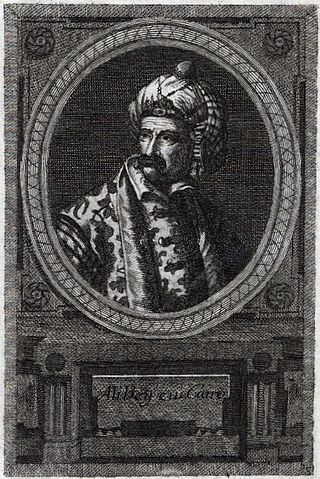
Ali Bey al-Kabir was a Mamluk leader in Egypt. Nicknamed Jinn Ali and Bulut Kapan ("Cloud-Catcher"), Ali Bey rose to prominence in 1768 when he rebelled against his Ottoman rulers, making the Egypt Eyalet of the Ottoman Empire independent for a short time. His rule ended following the insubordination of his most trusted general, Abu al-Dahab, which led to Ali Bey's downfall and death.
Saud bin Abdulaziz Al Saud ruled the First Saudi State from 1803 to 1814. Saud annexed Mecca and Medina from the Ottoman Empire making him the first Al Saud ruler who received the title of the servant of the Two Holy Cities. During his rule the state experienced a significant level of strength and expansion for which he was called Saud Al Kabeer or Saud the Great.
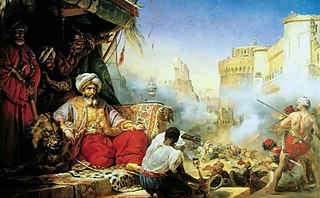
Muhammad Ali rose to power in Egypt came following a long, three-way civil war between the Ottoman Empire, Egyptian Mamluks who had ruled Egypt for centuries, and Albanian mercenaries in the service of the Ottomans. The conflict ended in victory for the mercenaries led by Ali.
The Ottoman/Egyptian-Wahhabi War also known as the Ottoman/Egyptian-Saudi War (1811–1818) was fought from early 1811 to 1818, between the Ottoman Empire and the Emirate of Diriyah, the First Saudi State, resulting in the destruction of the latter.

Ottoman Egypt was an administrative division of the Ottoman Empire after the conquest of Mamluk Egypt by the Ottomans in 1517. The Ottomans administered Egypt as a province (eyalet) of their empire. It remained formally an Ottoman province until 1914, though in practice it became increasingly autonomous during the 19th century and was under de facto British control from 1882.

Turco-Egyptian Sudan, also known as Turkiyya or Turkish Sudan, describes the rule of the Eyalet and later Khedivate of Egypt over what is now Sudan and South Sudan. It lasted from 1820, when Muhammad Ali Pasha started his conquest of Sudan, to the fall of Khartoum in 1885 to Muhammad Ahmad, the self-proclaimed Mahdi.

The Alexandria expedition of 1807, also known as the Fraser expedition, was a failed attempt by the British to capture the Egyptian city of Alexandria during the Anglo-Turkish War in order to secure a base of operations against the Ottoman Empire and the French Empire in the Mediterranean Sea. It was a part of a larger strategy against the Ottoman-French alliance of the Ottoman Sultan Selim III.

Ahmed Pasha al-Jazzar born Ahmed Pervan was the Acre-based Ottoman Bosnian governor of Sidon Eyalet from 1776 until his death in 1804 and the simultaneous governor of Damascus Eyalet in 1785–1786, 1790–1795, 1798–1799, and 1803–1804. Having left his native Bosnia as a youth, he began a military career in Egypt in the service of mamluk officials, eventually becoming a chief enforcer and assassin for Ali Bey al-Kabir, Egypt's practical ruler. He gained the epithet of al-Jazzar for his deadly ambush on a group of Bedouin tribesmen in retaliation for the death of his master in a Bedouin raid. Al-Jazzar fell out with Ali Bey in 1768 after refusing to take part in the assassination of one of his former masters. He ultimately fled to Syria, where he was tasked with defending Beirut from a joint assault by the Russian Navy and Zahir al-Umar, the Acre-based ruler of northern Palestine. He eventually surrendered and entered Zahir's service before defecting from him and fleeing with stolen tax money.

The Battle of Medina took place in 1812, Following the Battle of Al-Safra, Tusun's forces began to deal with Saudi forces stationed in Medina.
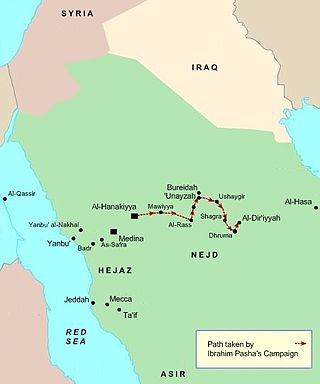
The Najd Expedition was a series of military conflicts waged by Egypt on behalf of the Ottoman Empire from 1817–1818. It was part of the Ottoman–Saudi War that lasted from 1811 to 1818. The campaign of 1817/8 was led by Ibrahim Pasha, with the goal of capturing Diriyah and ending the First Saudi State by the order of the Ottoman sultan Mahmud II.
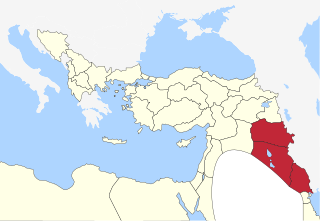
The Mamluk dynasty of Mesopotamia was a dynasty of Georgian Mamluk origin which ruled over Iraq in the 18th and early 19th centuries.

The Khedivate of Egypt was an autonomous tributary state of the Ottoman Empire, established and ruled by the Muhammad Ali Dynasty following the defeat and expulsion of Napoleon Bonaparte's forces which brought an end to the short-lived French occupation of Lower Egypt. The Khedivate of Egypt had also expanded to control present-day Sudan, South Sudan, Eritrea, Djibouti, northwestern Somalia, northeastern Ethiopia, Lebanon, Jordan, Syria, Greece, Cyprus, southern and central Turkey, in addition to parts from Libya, Chad, Central African Republic, and Democratic Republic of Congo, as well as northwestern Saudi Arabia, parts of Yemen and the Kingdom of Hejaz.

The Sharifate of Mecca or Emirate of Mecca was a state, non-sovereign for much of its existence, ruled by the Sharifs of Mecca. A sharif is a descendant of Hasan ibn Ali, Muhammad's grandson. In Western sources, the prince of Mecca was known as Grand Sherif, but Arabs have always used the appellation "Emir".

The Vilayet of the Hejaz refers to the Hejaz region of Arabia when it was administered as a first-level province (vilayet) of the Ottoman Empire. At the beginning of the 20th century, it reportedly had an area of 96,500 square miles (250,000 km2). The Hejaz included all land from the southern border of the Vilayet of Syria, south of the city of Ma‛an, to the northern border of the Vilayet of Yemen, north of the city of Al Lith.

Muhammad Ali was the Ottoman Albanian governor and de facto ruler of Egypt from 1805 to 1848, considered the founder of modern Egypt. At the height of his rule, he controlled Egypt, Sudan, Hejaz, Najd, the Levant, Crete and parts of Greece.
Müftizade Ahmed Pasha was an Ottoman statesman. He served myriad provincial governorships and high-level managerial roles throughout his career.
Uthman Pasha al-Kurji, was the Ottoman governor (wali) of Damascus Eyalet between 1760 and 1771.

Amir al-hajj was the position and title given to the commander of the annual Hajj pilgrim caravan by successive Muslim empires, from the 7th century until the 20th century. Since the Abbasid period, there were two main caravans, one departing from Damascus and the other from Cairo. Each of the two annual caravans was assigned an amir al-hajj whose main duties were securing funds and provisions for the caravan, and protecting it along the desert route to the Muslim holy cities of Mecca and Medina in the Hejaz.
Kunj Yusuf Pasha was an Ottoman Kurd who served as the governor of Damascus Eyalet between 1807 and 1810. As governor, Kunj Yusuf enacted discriminatory policies against religious minority groups in Damascus and was unable to secure the annual Hajj pilgrim caravan to Mecca. After his inability to defeat Wahhabi invaders in 1809, he was ousted by Sulayman Pasha al-Adil with the blessing of the Ottoman imperial authorities.
References
- 1 2 Grant, James. "Story of Thomas Keith." The Constable of France: And Other Military Historiettes. London: G. Routledge and Sons, 1866
- ↑ Philipp, Thomas, and Ulrich Haarmann. The Mamluks in Egyptian Politics and Society. Cambridge: Cambridge UP, 1998
- ↑ Burckhardt, John Lewis. Notes on the Bedouins and Wahábys: Collected during His Travels in the East. London: H. Colburn and R. Bentley, 1831
- ↑ Grant, James. "The Scots in the Land of the Turban." The Scottish Soldiers of Fortune, Their Adventures and Achievements in the Armies of Europe. London: Routledge, 1890